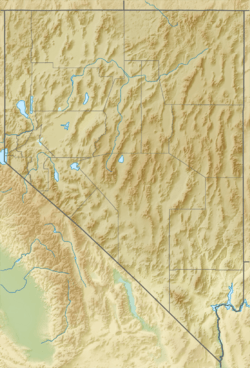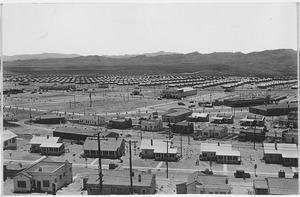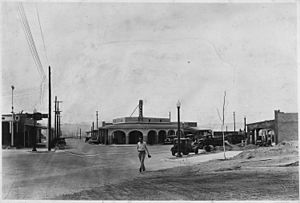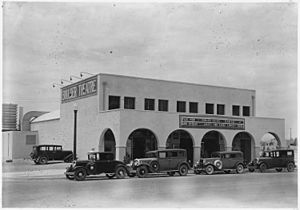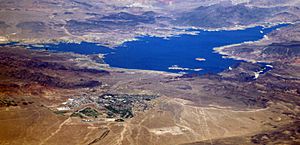Boulder City, Nevada facts for kids
Quick facts for kids
Boulder City, Nevada
|
||
|---|---|---|
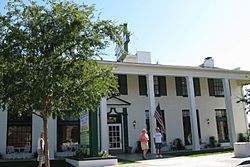
Boulder Dam Hotel built in 1933
|
||
|
||
| Nickname(s):
Home of Hoover Dam
|
||

Location within Clark County
|
||
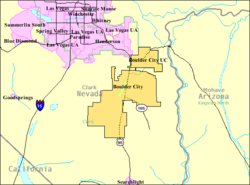
U.S. Census map
|
||
| Country | United States | |
| State | Nevada | |
| County | Clark | |
| Founded | 1931 | |
| Incorporated | January 4, 1960 | |
| Named for | Boulder Canyon | |
| Government | ||
| • Type | Council Manager | |
| Area | ||
| • Total | 208.30 sq mi (539.49 km2) | |
| • Land | 208.26 sq mi (539.40 km2) | |
| • Water | 0.03 sq mi (0.08 km2) | |
| Elevation | 2,510 ft (765 m) | |
| Population
(2020)
|
||
| • Total | 14,885 | |
| • Density | 71.47/sq mi (27.60/km2) | |
| Time zone | UTC−8 (PST) | |
| • Summer (DST) | UTC−7 (PDT) | |
| ZIP codes |
89005–89006
|
|
| Area code(s) | 702 and 725 | |
| FIPS code | 32-06500 | |
| GNIS feature ID | 858617 | |
Boulder City is a cool city in Clark County, Nevada, USA. It's about 26 miles (42 km) southeast of Las Vegas. In 2020, about 14,885 people lived there. The city got its name from Boulder Canyon. Fun fact: Boulder City is one of only two places in Nevada where gambling is not allowed! The other place is a town called Panaca.
Contents
History of Boulder City
Building a Home for Dam Workers
Boulder City was built in a very dry, desert area. It was created for one main reason: to house the thousands of workers who were building the Hoover Dam on the Colorado River. This huge dam was first called Boulder Dam from 1933 to 1947.
Before Boulder City was built, many men hoping to work on the dam lived in tents by the river. This temporary camp was known as "Ragtown."
The Bureau of Reclamation and a company called Six Companies, Inc. started building Boulder City in 1931. They needed a proper town because the dam project was so big and would take a long time. Boulder City was special because it was completely planned by the government. This was different from other "company towns" in the past, which were usually built by private companies.
Early Years: A Planned Community (1930–1934)
Boulder City was carefully designed to be a model community. A city planner named Saco Rienk de Boer helped create the layout. He had planned other cities and suburbs in the Rocky Mountain area.
The Hoover Dam project gave people hope during the Great Depression. Boulder City was also meant to show this positive spirit. The goal was to create a clean and healthy place for the dam workers to live.
DeBoer's first plan in 1930 was very formal, with a park and important buildings at the center. It was too expensive, so they changed it to have more regular blocks. Still, the town had lots of public spaces and green areas. People even called it "Nevada's Garden City." Creating green spaces was part of the Bureau of Reclamation's goal to make the American West more fertile.
The town was designed for about 5,000 workers. Where workers lived and how big their homes were showed their importance. The most important employees lived on top of the hill. Managers lived further down, and regular laborers lived furthest from the public buildings and parks. The areas for laborers had fewer open spaces and parks.
The city manager, Sims Ely, strictly controlled businesses. There were limits on how many different types of stores could open. Anyone wanting to start a business had to be approved.
Interestingly, there were no schools planned at first. The Bureau of Reclamation thought mostly single men would live there. But the city eventually got state-funded schools. There were also no hospitals at first. Injured workers had to go to Las Vegas, 33 miles (53 km) away. Even when a hospital opened in Boulder City, women were not allowed for several years.
Rules and Entertainment in Boulder City
Like many company towns, Boulder City had strict rules for its workers. Alcohol was not allowed until 1969, and gambling has always been against the rules. The city was founded during the Prohibition era, when alcohol was illegal across the country.
The Boulder Theatre opened in 1931, so workers didn't have to go to Las Vegas for fun. These rules and entertainment options were common in company towns. The idea was that workers who were sober, had nice homes, and local entertainment would be more productive.
Boulder City's rules about alcohol and gambling were also because Las Vegas was nearby and known for its wild nightlife. Visitors to Boulder City even needed a permit to enter, and by 1932, there was a gatehouse they had to pass through.
Growth and Modern Times
The government managed Boulder City until 1959, when it became an independent city. The official ceremony happened on January 4, 1960. The city council chose Robert N. Broadbent as the first mayor.
The city's rules, approved by its residents, still ban gambling. This makes Boulder City one of only two places in Nevada where gambling is illegal. Some places like the Hoover Dam Lodge and Railroad Pass Casino might have a Boulder City mailing address or phone number, but they are actually outside the city limits.
Alcohol sales were finally allowed in 1969.
In 2018, the Boulder City Bypass opened as part of the Interstate 11 project. This road goes around the main part of Boulder City. At first, people worried it would hurt local businesses, but it seems to have helped some of them instead.
Geography and Climate
Boulder City is a very large city in terms of land area. It covers about 208.3 square miles (540.2 sq km). Only a tiny part of this is water. This makes Boulder City the largest city in Nevada by land size. However, it has a low population density, with only about 72 people per square mile.
Boulder City has strict rules about how much it can grow. Only 120 permits for new homes are given out each year. Hotels are also limited to 35 rooms or less. These rules help keep the city from getting too crowded.
Weather in Boulder City
Boulder City has a hot desert climate. This means it gets very hot and dry.
| Climate data for Boulder City | |||||||||||||
|---|---|---|---|---|---|---|---|---|---|---|---|---|---|
| Month | Jan | Feb | Mar | Apr | May | Jun | Jul | Aug | Sep | Oct | Nov | Dec | Year |
| Record high °F (°C) | 75 (24) |
86 (30) |
91 (33) |
97 (36) |
111 (44) |
114 (46) |
117 (47) |
112 (44) |
110 (43) |
100 (38) |
90 (32) |
78 (26) |
117 (47) |
| Mean daily maximum °F (°C) | 54.5 (12.5) |
59.9 (15.5) |
67.6 (19.8) |
76.4 (24.7) |
85.9 (29.9) |
95.9 (35.5) |
101.6 (38.7) |
99.5 (37.5) |
92.6 (33.7) |
79.8 (26.6) |
64.5 (18.1) |
55.6 (13.1) |
77.8 (25.4) |
| Mean daily minimum °F (°C) | 38.6 (3.7) |
42.3 (5.7) |
47 (8) |
53.8 (12.1) |
61.9 (16.6) |
70.4 (21.3) |
76.7 (24.8) |
75.4 (24.1) |
69 (21) |
58.5 (14.7) |
46.6 (8.1) |
39.7 (4.3) |
56.7 (13.7) |
| Record low °F (°C) | 11 (−12) |
12 (−11) |
25 (−4) |
31 (−1) |
37 (3) |
41 (5) |
56 (13) |
59 (15) |
43 (6) |
30 (−1) |
26 (−3) |
9 (−13) |
9 (−13) |
| Average precipitation inches (mm) | 0.66 (17) |
0.64 (16) |
0.66 (17) |
0.34 (8.6) |
0.18 (4.6) |
0.09 (2.3) |
0.49 (12) |
0.71 (18) |
0.51 (13) |
0.32 (8.1) |
0.43 (11) |
0.51 (13) |
5.55 (141) |
| Average snowfall inches (cm) | 0.6 (1.5) |
0.1 (0.25) |
0.1 (0.25) |
0 (0) |
0 (0) |
0 (0) |
0 (0) |
0 (0) |
0 (0) |
0 (0) |
0 (0) |
0.1 (0.25) |
1 (2.5) |
| Average precipitation days | 3 | 4 | 4 | 2 | 1 | 1 | 3 | 3 | 2 | 2 | 2 | 3 | 30 |
| Source: WRCC | |||||||||||||
People of Boulder City (Demographics)
| Historical population | |||
|---|---|---|---|
| Census | Pop. | %± | |
| 1950 | 3,903 | — | |
| 1960 | 4,059 | 4.0% | |
| 1970 | 5,223 | 28.7% | |
| 1980 | 9,590 | 83.6% | |
| 1990 | 12,567 | 31.0% | |
| 2000 | 14,966 | 19.1% | |
| 2010 | 15,023 | 0.4% | |
| 2020 | 14,885 | −0.9% | |
| U.S. Decennial Census | |||
In 2000, there were about 14,966 people living in Boulder City. Most residents (94.5%) were White. About 4.3% of the population was Hispanic or Latino.
The average household had 2.30 people, and the average family had 2.79 people. About 23.6% of households had children under 18. The median age in the city was 47 years old.
By 2020, the population was 14,885 people. The racial makeup was 88.9% White. About 8.4% of people were Hispanic or Latino.
The average household size was 2.37 people. About 18.1% of people were under 18, and 29% were older than 65. The median income for a household was $69,746.
Economy and Attractions
Hoover Dam's Influence
The Hoover Dam is very close to Boulder City, and it influences many local businesses. The historic downtown area has the Boulder Dam Hotel, which also houses the Boulder City/Hoover Dam Museum. The hotel is named after the dam's original name.
The Boulder City Chamber of Commerce uses the fun slogan "Best City By A Dam Site" in its promotions. The city also hosts an annual event called "The Dam Short Film Festival".
Fun Places to Visit
Boulder City has many interesting places to see and things to do:
- Alan Bible Botanical Garden
- Bootleg Canyon Mountain Bike Park
- Hoover Dam Museum
- Hoover Dam
- Lake Mead
- Nevada Southern Railroad Museum
- Boulder City Conservation Easement
Sports and Recreation
In 1975, a team from Boulder City won a national TV competition called Almost Anything Goes! They even won a "Supergames" playoff the next year!
Boulder City has lots of ways to stay active:
- Two public golf courses (Boulder City Municipal Golf Course and Boulder Creek Golf Course)
- One private golf course
- A city swimming pool
- Racquetball courts
- Lit tennis courts
- Athletic fields
- A BMX bicycle track
- Many mountain hiking trails
- It's just a few miles from Lake Mead, where you can enjoy water activities.
Nevada's first airport, Boulder City Municipal Airport, is still open today. You can take private planes, go skydiving, or enjoy scenic flights over Hoover Dam and the Grand Canyon from here.
Education in Boulder City
Boulder City has four public schools, which are part of the Clark County School District.
- Boulder City High School serves students in grades 9-12. It has about 700-750 students and was named a five-star school in 2012.
- Elton & Madeline Garrett Junior High School is for grades 6-8.
- Martha P. King Elementary School serves grades 3-5.
- Andrew J. Mitchell Elementary School is for grades K-2.
There is also a private Christian elementary school called Grace Christian Academy for grades K-5.
Boulder City also has a small campus of the College of Southern Nevada.
The Boulder City Library was even mentioned in the Oscar-winning movie La La Land. However, the scenes for the movie were actually filmed in California, not in Boulder City.
Local News
The Boulder City Review newspaper is published by Stephens Media. There used to be another local paper called the Boulder City News, but it stopped publishing in 2009.
City Infrastructure
Boulder City has an "Eldorado Energy Zone" in the northern Eldorado Valley. This area has a large natural gas power plant and other energy projects. In 2019, the city planned to lease land for a big solar power facility, hoping to earn $1.65 million each year from it.
Important facilities in Boulder City include:
- Boulder City Hospital
- Boulder Dam Hotel
- Copper Mountain Solar Facility
Transportation
Here are the main highways that go through Boulder City:
 Interstate 11
Interstate 11 U.S. Route 93
U.S. Route 93
 U.S. Route 93 Business (Boulder City, Nevada)
U.S. Route 93 Business (Boulder City, Nevada) U.S. Route 95
U.S. Route 95 State Route 165
State Route 165 State Route 173
State Route 173
Famous People from Boulder City
- Desi Arnaz, Jr. (born 1953) – An actor and musician who owns the Boulder Theatre with his wife.
- Paul C. Fisher (1913–2006) – The inventor of the famous Fisher Spacepen Co., which is located in Boulder City.
- Terry Goodkind (1948–2020) – A writer known for his fantasy series The Sword of Truth.
Images for kids
-
Estate homes overlooking Lake Mead
See also
 In Spanish: Boulder City (Nevada) para niños
In Spanish: Boulder City (Nevada) para niños



